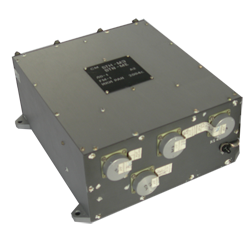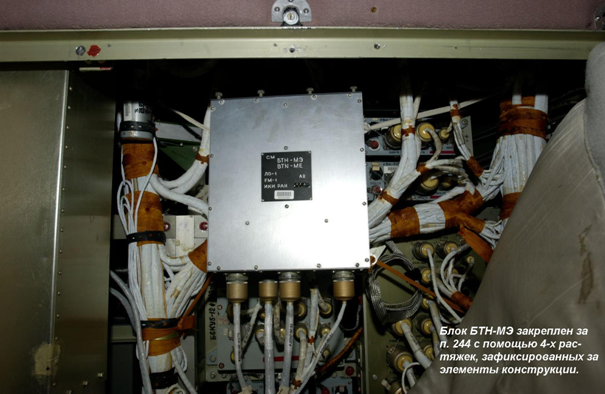BTN-Neutron space experiment onboard the International Space Station. First stage of the experiment using the BTN-M1 instrument
-------------------------------------------------------------------------------------------------------------------------------------------------
-------------------------------------------------------------------------------------------------------------------------------------------------

BTN-M1 scientific instrument is designed for BTN-Neutron experiment for fast and thermal neutron studies onboard the Service Module within Russian Orbital Segment of the International Space Station (ISS). Further information on the ISS is available at http://www.energia.ru/energia/iss/iss.html
BTN-Neutron space experiment is aimed at the study of spatial and temporal distribution of neutron fluxes in the near-Earth space, and during solar flares in particular. Expected results will greatly improve our understanding of the physical processes that end up with neutron generation during solar flares. They will also help us to estimate neutrons' contribution to the total radiation dose to which the cosmonauts are exposed during extravehicular activities.
Neutrons in the near-Earth space are born when galactic and solar cosmic rays (GCR and SCR) interact with Earth's upper atmosphere, as well as from irradiation with cosmic rays and particles of radiation belts of the ISS structural elements and also from powerful solar flares. Neutron registration in the ISS orbit would help to determine the neutron fluxes' dependence on geographical coordinates and the ISS altitude, on the current state of terrestrial magnetosphere and atmosphere, and on solar activity.
To achieve these goals, the instrument should be capable to measure the following physical parameters in orbit around the Earth:
- neutron fluxes in a wide energy range starting from 0.4 eV to fast neutrons with energies of up to 10 MeV;
- gamma-ray radiation in the energy range from 60 keV to 10 MeV.
The data obtained during the experiment would allow:
- to develop a physical model of the Earth's atmospheric neutron albedo with regard to its dependence on measuring point's longitude and latitude, time of the day and illumination conditions, atmospheric parameters;
- to develop a physical model of the neutron background around the ISS with regard to different flight conditions;
- to develop a physical model describing charged and neutral particles generation during solar flares;
- to solve supplementary scientific tasks that are:
- simultaneous registration of solar protons and products of their interactions with terrestrial and martian atmospheres. This can be done with the help of BTN-M1 working synchronously with the HEND instrument onboard Mars Odyssey spacecraft in orbit around Mars. Solar flares are registered simultaneously near the Earth and Mars, thus improving the reliability of registration and making data more informative (the information includes energy spectrum and time profile of the flare, features of the radiation propagation in the interplanetary space, etc);
- simultaneous registration of gamma-ray bursts in orbits around the Earth and Mars allows to apply triangulation method to estimate the direction towards GRB sources, and observe GRB afterglows in other energy ranges together with other space and ground-based observatories;
- study of radiation hardness of new scintillators, samples of which are placed inside electronics unit of the instrument and then are delivered back to the Earth. These scintillation materials are intended for use in future space experiments, among others, for further stages of “BTN-Neutron” experiment.
BTN-M1 exploits principle of detecting neutrons and gamma-rays born or scattered in the Earth's atmosphere and within construction materials and elements of ISS, as well as those coming from the Sun or other space sources.
This instrument is essentially a spectrometer with four independent neutron detectors. Three epithermal neutron detectors (SD, MD, and LD in Fig. 1) are proportional gas counters with 3He and the fourth high energy neutron detector (SC in the Fig. 1) is made from C14H12 stilbene crystal placed inside active anticoincidence shield made from CsI:Tl3+ crystal.
Equipment used for the experiment:
- BTN-MD detection module (built by IKI) — HEND flight unit № 2 (https://np.cosmos.ru/hend-en.html), modified according to specific requirements for the ISS equipment and placed into special BTN-MF mounting box (built by IKI),
- additionally developed BTN-ME electronic module (built by IKI),
- set of cables to connect modules inside and outside the ISS (built by RSC Energia),
- special frame to place BTN-MD detecting module on the outer surface of the Zvezda Service Module (built by RSC Energia).
Detecting module includes HEND flight unit №2 (Fig. 1) placed into BTN-MF truss, which provides mechanical vibroinsulated mounting of BTN-MD, sockets for electrical connection with the ISS cable system, and supports thermal regime using thermal radiators and vacuum shield thermal insulation (Fig. 2).

Fig. 1. Scheme of the HEND instrument used as BTN-MD detecting module (SD — small 3He detector, MD — medium 3He detector, LD — large 3He detector, SC — scintillation detector)

Fig. 2. BTN-MD module assembled with BTN-MF truss with radiators, covered by temporary insulation
Scientific tasks of the experiment required that axis of scintillator of BTN-MD module was normally pointed to zenith. Additionally, there were specific requirements concerning instrument storage inside the ISS, its mounting and unmounting by cosmonauts in space suits. To comply with these requirements a special assembly equipment was designed by RSC Energia specialists, combining special bracket (fig. 3), intermediate (transition) platform, and three quick-release locks, to which BTN-MD+BTN-MF assembly was mounted.

Fig. 3. External BTN-MD module assembled with the truss (1 — BTN-MD, 2 — truss, 3 — arm, 4 — quick-release latches, 5 — cables, 6 — temporary protective cover)
BTN-ME electronics module (Fig. 4) is designed to match HEND electrical interfaces to those of service systems of the Service Module within the ISS Russian Orbital Segment, including:
- power supply interface;
- command and control interface;
- telemetry and scientific data interface;
- time signals translation interface.

Fig. 4. BTN-ME module
BTN-ME also contained special boards (Fig. 5) with passive detector's assemblies (PDA) which include crystals that can be possibly used in future scintillators((LaBr3):Ce3+, (LaCl3):Ce3+, (Lu0.5Y0.5)AlO3:Ce3+, (Lu0.7Y0.3)AlO3:Ce3+, (Lu0.7Y0.3)AlO3:Ce3+, (Lu2SiO5):Ce3+, (YAlO3):Ce3+) and passive dosimeters to study radiation resistance of scintillators and their potential use in the next stages of the BTN-Neutron space experiment. PDAs, after having been exposed in orbit for no less than 6 months, were delivered to the Earth to study scintillators' degradation under space radiation.

Fig. 5 BTN-ME module internal structure (left — PDA boards with crystals to be tested and dosimeters, right — electronic boards)
The BTN-M1 equipment was delivered to the ISS in October 2006 on board Progress № 358 cargo SC.
It was mounted and turned on in November 2006 – February 2007 by crew members of the 14th long-term expedition — a Russian cosmonaut Mikhail Tyurin and a US astronaut Michael Lopez-Alegria.
BTN-MD module was placed at the station's outer surface and mounted to the 2331 and 2333 handrails of Zvezda Service Module (the Russian Orbital Segment of the ISS, Fig. 6 and 7).

Fig. 6. Detector module is being mounted outside Zvezda Service Module

Fig. 7. ISS overview and BTN-M1 detector module location on the outer side of Zvezda module
BTN-ME module is placed inside the station (Fig.8).

Fig. 8. BTN-ME module location. BTN-ME module is fastened to the handrail 244 with 4 plastic wires fixed at the construction elements
Starting from February 2007, BTN-M1 aboard the ISS has been working normally transmitting scientific and telemetry data.
| Mass : | BTN-MD 6.4 kg BTN-ME 3.4 kg |
| Power consumption : | BTN-MD 8.7 W BTN-ME 3.4 W |
| Dimensions : | BTN-MD 245 x 280 x 330 mm BTN-ME 255 x 265 x 115 mm |
| Energy range : | from 0.4 eV to 15 MeV (neutrons) from 60 keV to 10 MeV (gamma rays) |
| Time resolution : | 0.25–256 sec |
| Working temperature range : | from −40 to +50 degrees Celsiusо |
| Telemetry volume : | 3 Мb per day |
| Warranty period : | 5 years |
Funding organization ― Open Joint-Stock Company S.P. Korolev Rocket and Space Corporation Energia (RSC Energia).
Primary contractor, space experiment organizer, and instrument designer ― Space Research Institute of the Russian Academy of Sciences (IKI RAS).
Principal Investigator ― Dr. Igor Mitrofanov.
Works on BTN-Neutron theme from 2002 to 2006 with regard to BTN-M1 scientific equipment development (design, building, testing, calibrating, delivery to the customer, complex testing, delivery, and testing at Baikonur) were led on the basis of the contract №828 of March 15, 2002 with RSC Energia.
Works on BTN-Neutron project from 2006 to 2010 (operating, scientific and telemetry data storing and processing) are led on the basis of the contract №1173 of October 15, 2007.
| S.P. Korolev Rocket and Space Corporation Energia (Korolev, Moscow distr.) |
Funding organization. Hydrolab testing and crew trainings. Instrument testing on the complex ISS testbed. Experiment support onboard the ISS in operation control, scientific data receiving and telemetry data processing. |
| Joint Institute for Nuclear Research (JINR, Dubna, Moscow district) |
Participation in BTN physical scheme development, numerical modeling of BTN counting parameters; preparation for and calibrations of the instrument' units on natural (isotopic) and artificial (generator) neutron sources. |
| A.A. Blagonravov Institute for Engineering Science of the Russian Academy of Sciences (IMASH, Moscow) |
Development of the mathematical model of the instrument mechanical structure; participation in the development of testing facilities for the BTN instrument in compliance with the Funding organization requirements; development of mechanical test programs for the instrument; support of the instrument testing. |
| Joint-Stock-Company «Specialized scientific research institute for instrumentation engineering» (SNIIP, Moscow) |
Electronic scheme design development for scintillation tract for fast neutron registration. |
| N.M. Fedorovsky All-Russian Scientific Research Institute for Mineral Raw Materials (Moscow) |
Scintillation unit development for fast neutrons registration. |
BTN-M1 measurements made from February 2007 up to now were used to map neutron fluxes in ISS vicinity and radiation dose accumulation rate, which helped to estimate radiation environment at the station and to study dependence of the upper atmosphere neutron albedo on charged particle flux in the magnetosphere.
As the additional task of the experiment on gamma-ray bursts registration, gamma profiles obtained by the CsI:Tl3+ detector (time resolution 1 sec and 0.25 sec) are analyzed and compared with the data obtained by the instruments onboard other spacecrafts.
Since most neutrons are generated due to galactic cosmic rays interactions with terrestrial atmosphere (as it is for BTN-M1 onboard the ISS) or with Martian surface (for HEND onboard Mars Odyssey), galactic cosmic rays trend, related to solar activity variations in 2007–2008, was estimated, using variations in albedo neutron fluxes at Solis Planum subequatorial region on Mars and equatorial and circumpolar regions of the Earth.
Among other results:
- Catalog of solar flares and solar proton events has been compiled;
- Anomalous cosmic ray region is recorded in the ISS orbit;
- Long-term operation of the instrument made it possible to detect a trend of galactic cosmic rays (GCR), which correlates with ground-based monitors and the data from other space experiments;
- Neutron spectrum was restored in the energy range of 0.4 eV to 10 MeV for various GCR flux conditions;
- Map of the distribution of the neutron dose rate for various GCR fluxes was constructed.



